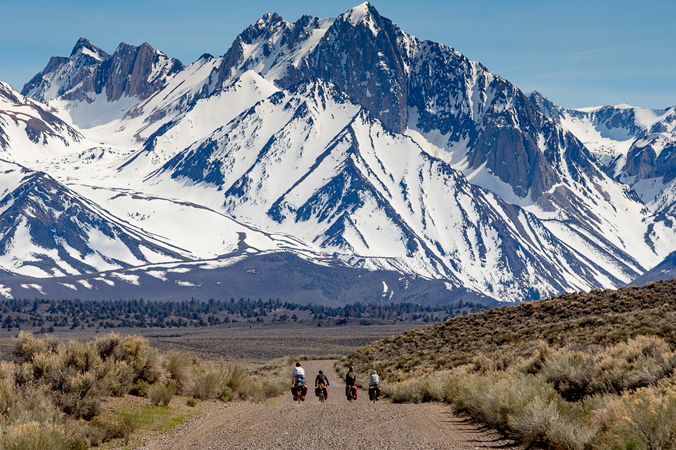
The author, Nick Russell, Eric Pollard and Joel Oberly set their sights on California’s Eastern Sierra Nevada Mountains. [Photo] Andrew Miller
Alpine starts have a buffer built into them. Rising a few minutes late is no problem. A half-hour’s delay is fine if you’re planning to hustle. Some individuals will even allow an hour. But missing a start completely is something I’d never entertained until last May, when morning light illuminated the east face of Mt. Wood in California’s Eastern Sierra Nevada Mountains.
I awoke to appreciate the immense beauty of the landscape, then shunned the four o’clock alarm and went right back to sleep. For the first time in my life, I wanted nothing to do with skiing. And later, after two breakfasts, we turned our bikes in the opposite direction of the Sierra’s snow-covered peaks toward the high desert and, more specifically, the Green Church hot springs.
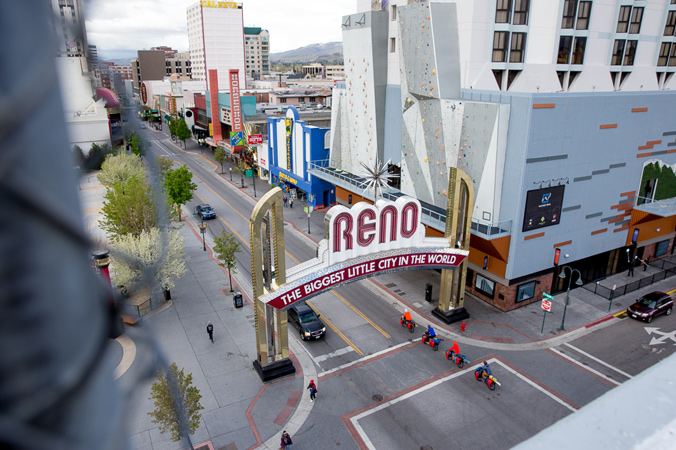
Wheeling and dealing on the way out of Reno, Nevada. [Photo] Andrew Miller
After six days spent biking and skiing from Reno, Nevada, our crew of six needed a rest day. Our desire to ride every line we could see had been tempered by almost 200 miles in the saddle, and we still had 200 miles to reach our final destination, Mt. Whitney. Thankfully, we’d remembered a shortcut to the hot springs that was nine miles less than our planned route down Highway 395. We were quickly reminded, however, that washboard roads aren’t shorter when your bicycle is loaded with more than 100 pounds of ski gear, camping equipment and food. We are off-the-couch bikers, after all, more versed in miles per hour than miles per day.
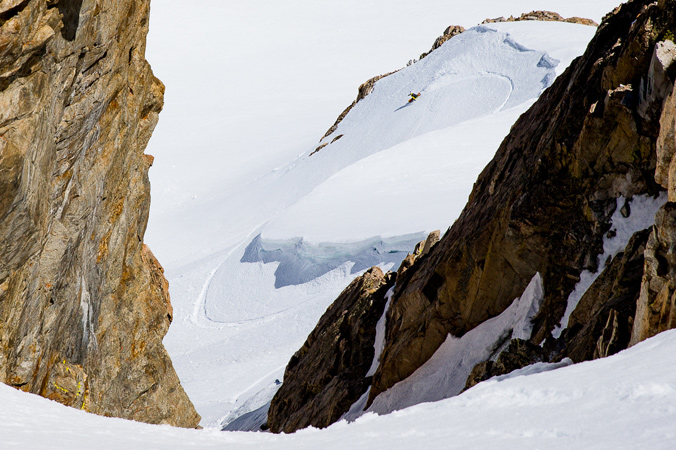
Nick Russell coasts down Tioga Pass’s Dana Plateau. [Photo] Andrew Miller
We reached the hot springs about seven hours after our not-so-alpine-start near the flank of Mt. Wood. Just before sundown, the tubs full of people whose fast cars had surpassed our steel steeds severely disrupted the warm promise of healing waters. We found a place to rest in the parking lot beside a Subaru named Bill Murray, according to the decal across his back window, and pursued the never-ending quest to consume enough calories and water. After the tubs cleared out, well past dusk, we soaked our sore and exhausted bodies and fell asleep on a patch of semi-flat dirt 30 feet from the boiling water.
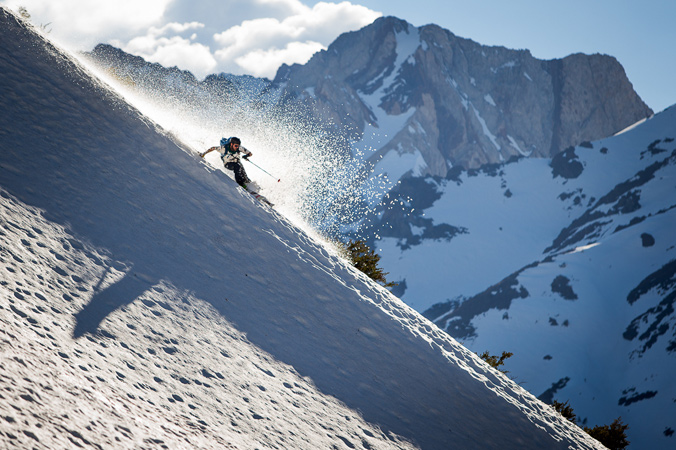
The author casts light on his new favorite mode for reaching trailheads. McGee Creek, Calif. [Photo] Andrew Miller
Wanting to experience a place from a different, slower perspective isn’t new—inspired men and women have done so for years. William Stafford, a prolific 20th-century poet, romanticized the quotidian experience of riding his bike home from work in his poem Maybe Alone on My Bike. In the second stanza, he writes:
And I have thought (maybe alone
on my bike, quaintly on a cold
evening pedaling home) think!—
the splendor of our life, its current unknown
as those mountains, the scene no one sees.
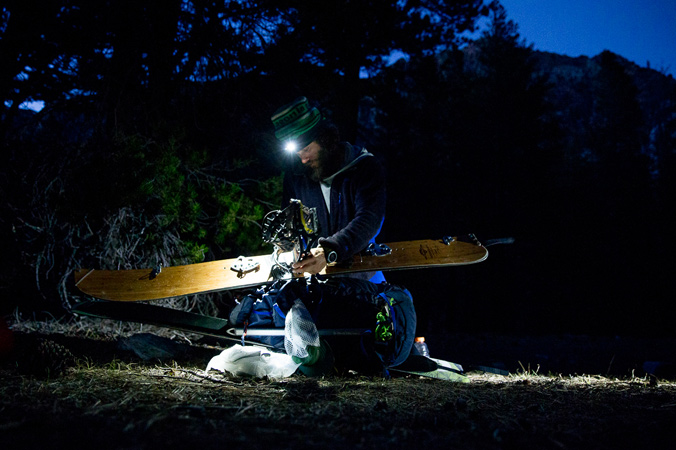
Nick Russell shifts gears before dawn on Tioga Pass. [Photo] Andrew MIller
Biking is romantic in its seeming simplicity—all you need are gear, gears, food, water and the will to keep pedaling. I wanted to reconfigure my approach to skiing, so instead of packing the car and driving to the trailhead, we planned to start on bikes from my front door in northwest Reno and pedal to the base of the Sierra, ready to summit peaks and rip lines under our own power. We’d ride through winds that would knock us over and stop us in our paths, up hills that would never end, on roads that would shake me to my core and, along the way, we’d ski ice, corn and everything in between on classics like Tioga Pass and Esha Peak, as well as unnamed couloirs, slopes and snow banks. Summiting and descending Mt. Whitney, the tallest peak in the lower 48, would serve as the finale to our 400-mile journey.

The chain gang on the long, straight approach up the Whitney Portal. [Photo] Christian Pondella
Just four days into our trip, we were so tired from the biking that, by the time we hit snowline, other skiers seemed to run by us on the skintrack, beating us to the summit and skiing the lines we were headed toward. The initial embarrassment turned to a point of pride as we acknowledged that the reason behind our heavy-legged exhaustion was hundreds of miles on the bike. We began marking each ski run as a first descent, because the approach had started in Reno, and because I was pretty sure no one else had previously taken our roundabout route. Pedaling slowed us down, dulled our competitive spirits and allowed us to laugh as we struggled through delirium and fatigue to perform a daily routine: climbing uphill to ski down.
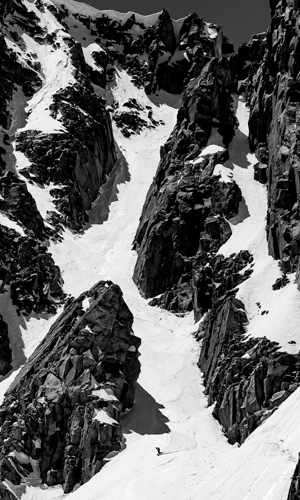
Nick Russell takes some time out of the saddle on Tioga Pass’s Dana Plateau. [Photo] Andrew Miller
When contemplating whom to invite, I figured the team could go a couple ways: hardcore ounce counters or thrill-seeking freestylers. I have friends in both circles, and either would be fine, but the real criteria came down to humor. I theorized that this trip might be a physically brutal undertaking, so the best partners would be those who could take your mind off the pain with a little laughter during the hard moments.
Joel Oberly is the kind of guy who makes the skintrack as fun as the downhill with his neverending jokes, ability to relate to anyone and mad-scientist beard; he’s not afraid to wear multiple prints, either. There was no end to Nick Russell’s energy supplies—even after hours of biking and slogging uphill for thousands of feet, he still looked for more runs at the end of the day. Eric Pollard (not the pro skier) was our guru, resident bike mechanic and camp-cook extraordinaire. Eric Messier and Gray Thompson hung behind the lens, making a movie for their production company Warp Wave, biking alongside and ripping turns with tripods on their backs. Together, the crew served as an assemblage of personalities guaranteed to, quite literally, keep the wheels moving.
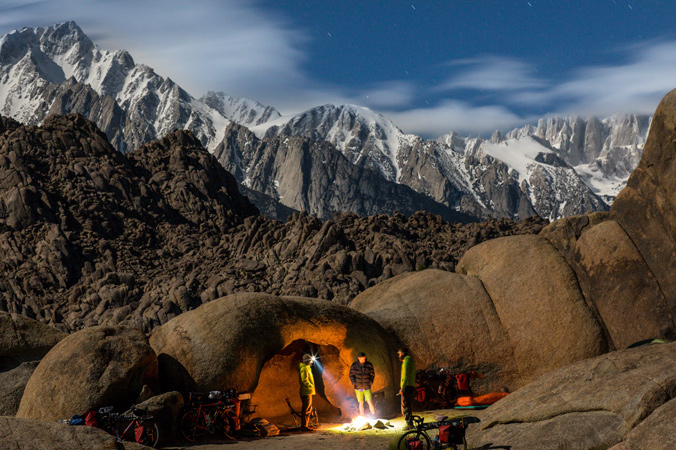
A pit stop at Alabama Hills before heading up to Mt. Whitney, the end of the 400-mile tour. [Photo] Christian Pondella
I’ll never forget Nick’s choice to only bring one pair of socks for two weeks spent bike touring and splitboarding—or his ear-to-ear grin upon finding a fresh pair in the care package we received on day nine in Bishop, Calif. I’ll always remember the ride up to Mammoth Mountain, scanning two-way radio channels for chatter and pranking families as we rode near the base. Or the time I punched the shell of my left ski boot using a camp stove at the bottom of Tioga Pass. Or the prized, king-size tube of Chamois Butter brought by Nick and Gray, who were deathly afraid of the chafing that two weeks of saddle time might—and eventually did—bring upon us amateur bike tourers.
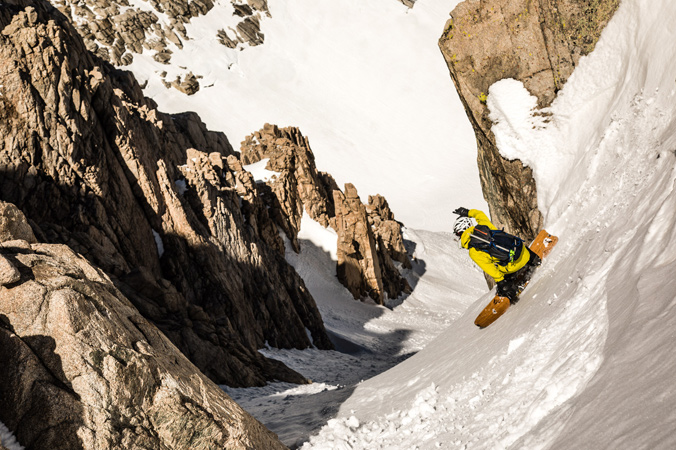
Russell keeps the adventure going on Mt. Whitney. [Photo] Christian Pondella
Here are some lessons from the road: the way of the bike is slow and, because of this, as William Stafford observed, there is more time to appreciate the view. The bike is a model of efficiency. On it, you can’t afford to waste energy or you won’t get anywhere. The bike makes you tired in the short term but rejuvenated over time. You only need one gear on a bike, but a few options are a nice bonus. Maintenance is mandatory, and a flat tire means a break for food and an opportunity for teamwork and problem solving.
We so often choose the automobile in an effort to expedite travel time and get to wherever we’re going more quickly. In this way, travelling is an interruption of the intended event. But on a bike, travelling is an event itself. On a bike, the adventure never ends.










Related posts:
The Leader: Caroline Gleich on The Chuting Gallery
White Trash: An essay by Allan Bard & Tom Carter
Hips Don’t Lie: How a solid foundation leads to strong skinning
The Backside of Beyond: An essay by the late Allan Bard